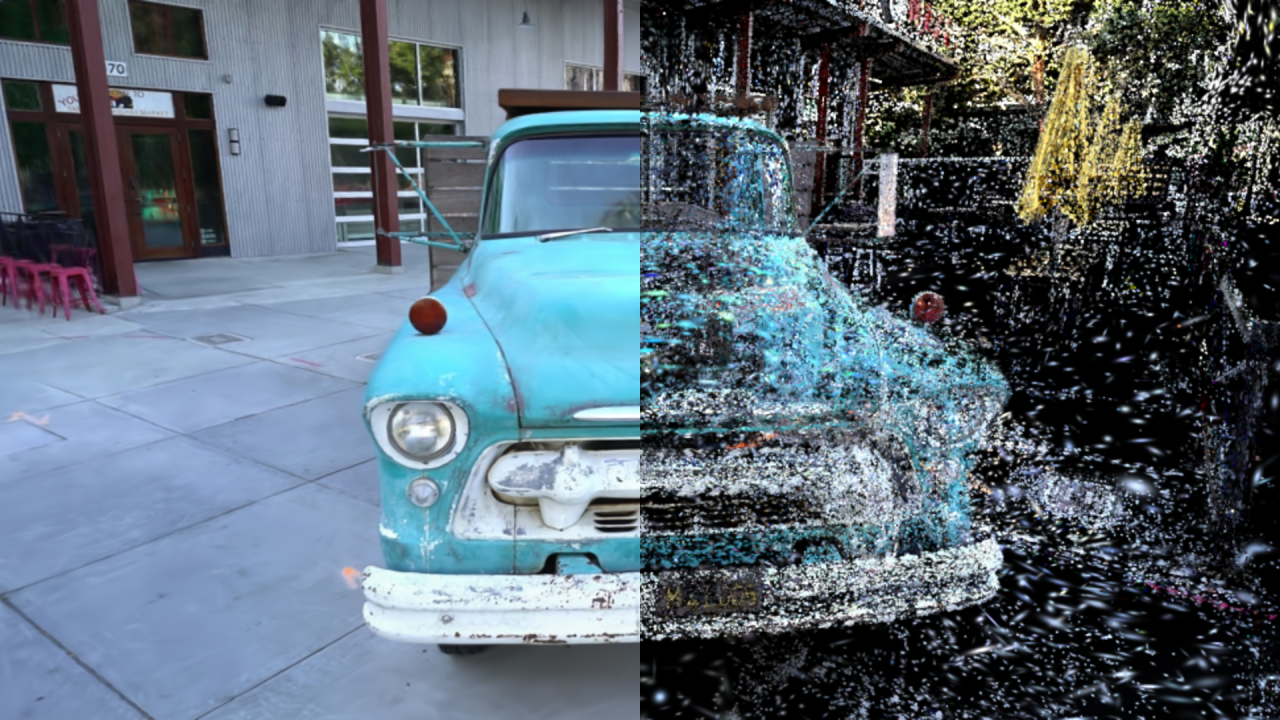Advances in 3D Gaussian Splatting: Pioneering the Future of 3D Reconstruction and Novel View Synthesis
Street Gaussians: Modeling Dynamic Urban Scenes with Gaussian Splatting (Github)
3D Gaussian Splatting (3DGS) has emerged as a revolutionary technique in the realm of computer graphics, providing unprecedented advancements in rendering speed and quality for novel view synthesis and 3D reconstruction. Unlike traditional methods like Neural Radiance Fields (NeRFs), 3DGS utilises Gaussian ellipsoids to represent scenes, offering efficient and high-quality rendering capabilities. This blog post delves into the recent advancements and diverse applications of this innovative technique, highlighting its transformative impact across various fields.
The Evolution and Benefits of 3D Gaussian Splatting
3DGS marks a significant departure from neural implicit representations to explicit modeling using Gaussian ellipsoids. This shift brings numerous benefits:
Real-time Rendering: One of the standout features of 3DGS is its ability to achieve real-time rendering speeds, making it ideal for applications in virtual reality and real-time simulations.
High-Quality Reconstruction: The technique enhances the visual quality of novel view synthesis by minimising artifacts and effectively handling occlusions, surpassing the performance of previous methods.
Efficient Data Compression: Recent research has focused on reducing computational load and improving data storage efficiency through methods like vector quantisation and octree-based compression (Dalal et al., 2024; Wu et al., 2024).
"3D Gaussian splatting not only achieves comparable novel view synthesis quality but also allows fast convergence and real-time rendering," (Dalal et al., 2024).
Cutting-Edge Techniques in 3D Gaussian Splatting
Several innovative techniques have been developed to enhance the capabilities of 3DGS:
Mip-Splatting: This technique addresses aliasing issues by applying a 3D smoothing filter to maintain the maximum frequency of 3D Gaussian primitives, resulting in enhanced rendering quality even in out-of-distribution scenarios (Wu et al., 2024).
Dynamic and Deformable Models: Techniques like 4D Gaussian Splatting capture dynamic details and motions in scenes, allowing for realistic animations and simulations. For instance, Dynamic 3D Gaussians leverage local-rigidity constraints to represent consistent space rotation, enabling dense 6-DOF tracking and reconstruction without correspondence or flow input (Yan et al., 2024; Wu et al., 2024).
Text-to-3D Generation: Methods such as Gaussian-Dreamer utilise diffusion models to generate detailed 3D models from text descriptions, showcasing the potential for creative content generation.
"Gaussian-Dreamer seamlessly connects 3D and 2D diffusion models through Gaussian splitting, ensuring both 3D consistency and intricate detail generation,"(Wu et al., 2024; Yan et al., 2024).
Introduction to 3D Gaussian Splatting - Dylan Ebert (Huggingface)
Diverse Applications Across Multiple Domains
3DGS's versatility is evident in its wide range of applications:
Avatars and Digital Humans: Techniques like Drivable 3D Gaussian Splatting (D3GA) enable real-time rendering of human avatars, which are crucial for virtual reality, gaming, and digital communication. This method leverages dense calibrated multi-view videos for real-time rendering, introducing tetrahedral cage-based deformations driven by keypoints and angles in joints (Dalal et al., 2024).
Simultaneous Localisation and Mapping (SLAM): GS-SLAM utilises 3D Gaussian representations for real-time SLAM applications, significantly enhancing the efficiency and accuracy of autonomous navigation systems.
"GS-SLAM strikes a balance between efficiency and accuracy by employing a real-time differentiable splatting rendering pipeline," explains a recent article (Wu et al., 2024).
3D Reconstruction from Sparse Views: Models like MVSplat use multi-view depth estimation to accurately reconstruct 3D scenes from sparse image sets, enhancing the flexibility and efficiency of 3D modeling. This method predicts Gaussian parameters in a pixel-aligned manner, enabling high-quality rendering and reconstruction from sparse-view images (Yan et al., 2024).
Addressing Challenges and Future Directions
Despite its impressive advancements, 3DGS faces several challenges that researchers aim to address:
Handling Complex Scenes: Future research is focused on improving the handling of complex scenes with varying illumination and dynamic objects, ensuring robust performance across diverse environments (Dalal et al., 2024).
Optimisation and Scalability: Efforts are ongoing to optimise the computational aspects and scalability of 3DGS, making it suitable for larger and more intricate scenes. This involves developing more efficient algorithms and data structures to manage the increased complexity (Yan et al., 2024).
Gaussian Splatting and the Future of Photogrammetry - Innoarea
Conclusion
3D Gaussian Splatting represents a significant leap forward in the fields of 3D reconstruction and novel view synthesis. Its ability to render high-quality images in real-time while efficiently managing computational resources makes it a valuable tool for a wide range of applications. As research continues to evolve, we can expect further innovations that will expand the capabilities and applications of this promising technology.
For those interested in diving deeper into the technical details and latest developments in 3D Gaussian Splatting, numerous scholarly articles and reviews provide comprehensive insights into this rapidly advancing field (Dalal et al., 2024; Wu et al., 2024; Yan et al., 2024).
By incorporating these advancements and addressing current challenges, 3D Gaussian Splatting is poised to transform the way we approach 3D reconstruction and novel view synthesis, paving the way for exciting new possibilities in computer graphics and beyond.
References
Dalal, A., Hagen, D., Robbersmyr, K. G. and Knausgård, K. M., 2024. Gaussian Splatting: 3D Reconstruction and Novel View Synthesis: A Review. IEEE Access, [online] Available at: https://ieeexplore.ieee.org/document/3408318.
Wu, T., Yuan, Y., Zhang, L., Yang, J., Cao, Y. and Yan, L., 2024. Recent Advances in 3D Gaussian Splatting. Computational Visual Media, [online] Available at: https://link.springer.com/article/10.1007/s41095-024-0436-y.
Yan, Z., Low, W. F., Chen, Y. and Lee, G. H., 2024. Multi-scale 3D Gaussian Splatting for Anti-aliased Rendering. arXiv preprint arXiv:2311.17089, [online] Available at: https://arxiv.org/abs/2311.17089.



